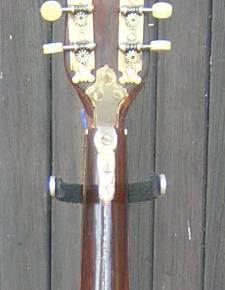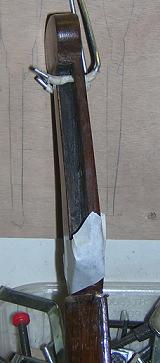| Snapped Heads
The head of the Italian mandolin is one of the most fragile areas, as they are generally glued to the end of the neck. This is a device of luthiers to save wood on the neck/head angle. This join has to support all the tension of the strings, at the point where the instrument is at its narrowest. It is often quite thin too, especially where enclosed tuners are used, and splits are also common along the lines of the tuner screws. German mandolins tend to be a little less prone to this problem, often with one-piece necks and heads. |
|||
| There are a variety of problems that relate to the head, apart from tuner problems. Here is one that so often marks the end of the life of a mandolin, especially the lightly-built, fragile Italians. | |||
| Where the narrow neck is cut into to house the nut, and with the tremendous string pressure (equivalent to 6-10lbs per string), breaks are all too frequent, (1) but happily not terminal. First the neck end is cleaned and levelled (2), and the same done to the head end (3). I even sometimes cut jagged ends off one side, to carefully glue back into the other to give me a sound platform for re-gluing. | |||
| I then drill out a hole in each side into which I will glue a dowel peg (4). It is not enough to just apply glue to the two ends, it is not strong enough, however, before setting in a dowel, the two parts must be solid, and the hole central, or there is a real risk of the pressure ripping the peg out through the back of the head or neck. Care must also be taken to get the head angle correct when rebuilding the ends.This is not a simple repair. Finally you can see the head and neck re-united (5) and held with tape whilst the glue sets. | |||
| Historially there are a lot of solutions to this problem, which can be seen on the backs of many instruments, below a few of these can be seen.... | |||
 |
 |
||
| A brass re-enforcement | Reglued after damage cut away | ||